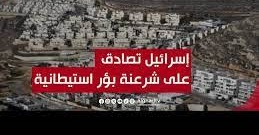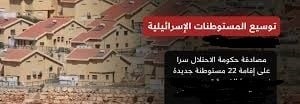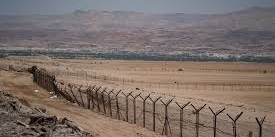By: Madeeha Al-A’raj
The National Bureau for Defending the Land and Resisting Settlements stated in its latest weekly report , that in a dangerous development, the Israeli Cabinet agreed at the end of last year to settle the status of 5 settlement outposts that launched 35 attacks against the Palestinians till now this year. The outposts are: “Givat Assaf, Avitar, Adorayim, Halitz, and Sde Ephraim”, to turn them into settlements to prevent territorial contiguity in the West Bank for the Palestinians in accordance to maps that reflect the meanings on the ground. Noting that at the beginning of this July, the Supreme Planning Council affiliated to the Israeli government legalized 3 random settlement outposts known as, “Mahaneh Gadi, Givat Hanan, and Kedem Arava.”
It is a settlement “coup” as described by many Israeli media sources, and it comes as an extension of the work of the 37th Israeli government since its formation at the end of the year 2022. The year 2023 is truly considered the year of the “settlement coup,” with accelerated practices implemented by the far-right government in the occupying state, with a policy that paves the way for achieving Smotrich’s vision to raise the number of settlers in the West Bank to one million settlers by the year 2030.
The most prominent of these practices, are: settling the status of 9 settlement outposts and turning them into Independent settlements and the actual start of settling the status of 63 other settlement outposts. This comes after the transfer of powers to use “state lands”| from the Civil Administration to ministries headed by settlers, and the announcement of the largest confiscation of areas since the signing of the Oslo Accords, as well as new Israeli natural reserves in the West Bank, in addition to the start of registering hundreds of biblical-heritage sites ‘falsely and slanderously’ to protect them from the “Palestinian danger.”
In the northern West Bank, the Occupation Authorities approved the legalization of the “Avitar” settlement outpost erected on the lands of Jabal Sabih, Beita, which the settlers consider it very important for settlement for a strategic reason. The talk is about a settlement located between two areas known as “B”, characterized by its strategic location, as it becomes a linking area between the Salfeet settlements and the settlements of the Jordan Valley ‘transit-Samaria’ on the one hand, and between the Nablus settlements and the Ramallah settlements St. 60 on the other hand. At a distance of tens of kilometers from there, the occupation authorities also approved “Givat Assaf,” the oldest settlement outpost on the list, which its goal is to create strategic communication between St. 60 and Beit Eil that located deep in private land.
To clarify, “Settlement St. 60 that work in it started in 1993, is one of the most important main settlement streets in the Palestinian territories, and it is the longest, with a length of about 240 km that passes through the West Bank from north to south, starting from Jenin and ending in Beersheba. It is a transit and linking street , as it crosses the West Bank from north to south, and links about 181 main and secondary roads.
“Sde Ephraim” is also a settlement outpost ‘farm’, poses a great challenge as Smotrich’s men wanted to legalize it, but the Americans opposed this and said, according to Israeli media, ‘except Sde Ephraim’. Despite this, the government neglected their view, and proceeded to legitimize it. The talk here is about land that forms a separator between two blocks of “B” land, leading to “Gush Talmonim” in the Ramallah Governorate that tThe occupation government plans to transform it into a Haredi city with 50,000 people. If the plan comes into effect, there will be intense regional communication between Modi’in Illit and Gush Talmonim.
The settlement outpost ‘Halitz – farm’ also completes a meaningful settlement outpost in the Bethlehem Governorate. It was not on any list of settlements for settlement, but the Settlement Directorate understood that this was a critical need because it linked Gush Etzion to Jerusalem and created a suffocating cordon on the northern side of Gush Etzion. “Halitz” farm continues communication with “Neve Ori” farm through the tunnel road. The fifth settlement is “Adorayim” in Mount Hebron, which is located on Route 60 between “Beit Haggai” and “Otniel.” The talk is about a highwayman between vast lands in area classified as “B”. Strengthening settlement in Mount Hebron is also at the top of the list of preferences of the occupation government, and the goal is the same, which prevents the establishment of a Palestinian State.
In parallel with the legitimization of more settlement outposts, settlement expansion projects, Judaization projects, and falsification of history and heritage in the occupied city of Jerusalem do not stop. The city is targeted by plans for Judaization and displacement, stealing more of its lands, and changing its features and map through the implementation of a series of malicious plans aimed at Judaizing its neighborhoods and surroundings and displacing its residents from them in the context of implementing the Greater Jerusalem Project. These days, the Israeli occupation is working to implement a new Judaization plan in the city of Jerusalem, especially in the areas surrounding the blessed Al-Aqsa Mosque.
Under the title “Reviving the Jewish Heritage,” the so-called Israeli Ministry of Heritage, in cooperation with several ministries and settlement associations, began implementing a new Judaization project in the city, with direct funding from the occupation Ministry of Finance, work on the new project began intensively by making changes on the ground, by raising the occupation flags, changing the gates of the Old City and the ancient shrines and landmarks that demonstrate its Arab-Islamic identity, as well as tightening security measures in Jerusalem.
According to Jerusalemite activists, the plan includes demolishing dozens of homes, reducing the number of Palestinians in the city, confiscating more Jerusalemite lands and property, and changing some Arab landmarks and placing Hebrew symbols on them. The extremist Minister of Finance, Smotrich allocated to the Ministry of Heritage a lucrative budget amounting NIS 364 million for the implementation of the project. The occupation focuses its plan on the areas of the so-called historic Holy Basin, with an area of 27,500 dunums, which begins from the Sheikh Jarrah neighborhood in the north, passing through the Old City, all the way to The town of Silwan, south of Al-Aqsa.
The most prominent landmarks targeted by the plan are the gates of the Old City, those surrounding Al-Aqsa Mosque, and the historical buildings dating back to the Greek, Ayiubid, and Ottoman periods, in addition to 3 hospitals built in the Ottoman period, the castle tower in Bab al-Khalil, some old Ottoman schools, historical Christian monuments, and huge buildings opposite the Hebron Gate, as well as, a number of streets in the areas of the Damascus Gate, Masrara, and Moroccan, and other historical monuments. The occupation Ministry of Finance transferred an additional sum to the Implementation and Demolition Procedures Department in the occupation municipality in Jerusalem, worth NIS 3 million in order to carry out more demolition operations in the city, as well as to put pressure on Jerusalemites and forcing them to ‘self-destruct’.
In Jerusalem also, the Local Committee for Planning and Construction in the occupation municipality, headed by Deputy Mayor, Eliezer Rauchberger, approved a settlement project that was presented last Wednesday, which is considered the largest in occupied Jerusalem, as it includes the construction of 7 towers with approximately 1,500 settlement units and thousands of square meters of commercial space on the Hebron Bethlehem St. with infrastructure to connect this new settlement bloc to the light-rail line that connects Jerusalem’s western and eastern parts, to the settlements.
According to details of the project that the occupation municipality’s website described as “tower madness,” the model of huge towers in Jerusalem continues, and this time towers reach a height of 47 floors. The project includes the demolition of 8 old buildings and replacing them with seven towers containing about 1,500 settlement units on confiscated private Palestinian lands located in the area opposite the Gilo settlement, to be connected during the project period, which is estimated at three years, to the future blue line of the light rail, which is expected to pass through the city of Hebron. This project will significantly increase the supply of settlement units in the area,from 348 settlement units that were planned in the year 2023 to 1,476 new settlement units.
The Occupation Municipality in Jerusalem has begun implementing its settlement plans for the year 2023-2027, and announced the completion of the light rail project, to connect the ‘Gilo settlement’ in the south, with the ‘Ramot settlement’ in the north this year. The light rail project, as it is known, includes 3 tracks, namely, ‘the “Green Line’, 20 km, the ‘Blue Line’ 31 km, and the ‘Brown Line’ 40 km long, which has not yet begun work, in addition to other sub-routes.
Recently, the occupation municipality has intensified infrastructure and settlement work to separate the city of Jerusalem from the city of Bethlehem, and the southern West Bank, with walls and thousands of settlement units, including the construction of streets, tunnels and roads, to connect the existing settlements on the lands of occupied East Jerusalem to each other, as well as to connect them with the settlements in the vicinity. The city and the highways leading to Tel Aviv via two parallel lines, “Begin Street” to the west, and “American Street” to the east, to isolate and marginalize the Palestinian villages and neighborhoods in East Jerusalem, expand settlement and settlements, and provide freedom of movement for settlers in what is called Greater Jerusalem.
List of Israeli Assaults over the Last Week Documented by the National Bureau:
Jerusalem:
- Forcing Aida Al-Qanbar in the Jabal Mukaber town to self-demolish her house under the pretext of unlicensed, otherwisw she has to pay NIS 80,000 if the occvupation municipality does so. Moreover, it also forced Bishara Al-Muhtasib to self-demolish his house in the same town to avoid paying heavy fines that exceeded NIS 20,000, and it notified the demolition of a 5-story residential building in the Shuafat Refugee Camp, while the occupation forces stormed the building of citizen Khalil Abu. Mayaleh handed him a notice to demolish the building under the pretext of building without a license.
- Demolishing a house under construction in the village of Um Tuba and forced citizen Walid Edkidek to demolish his house in the Al-Marwa Neighborhood in the town of Beit Hanina under the pretext of not having a license.
Hebron:
- Unleashing settlers’ herds of livestock into the fields and surroundings of Palestinian citizens’ homes in the “Fath Sidra” area, preventing them from leaving their homes and reaching their lands. Settlers grazed their sheep on citizens’ lands in Masafer Yatta in Wadi al-Jawaya near the village of al-Tuwanah, causing damage to crops and destroying a number of fruitful trees.
- Attacking citizens and beat old man, Mah’d Abu Qubaita, sustained bruises and wounds in the village of Al-Safeer in Al-Musafer. They also wreaked havoc on citizens’ property.
- Storming the archaeological sites in Tel Ma’in and Carmel, and performed Talmudic rituals and blew trumpets on the mountaintops, while others from the newly established settlement outpost in the “Khallet Taha” area, southwest of Hebron, fired live bullets towards citizens’ homes and attacked their tents.
- Attacking citizens’ tents and assaulted the women and children in the Dura town and the village of Birin village.
- Demolishing a house in the Khirbet Qalqas area, south of the city of Hebron, belonging to btthers, Sufyan and Mustafa Sidr that consists of 3 floors, each floor is 200m2, and houses more than 30 individuals, under the pretext of not having a license.
Bethlehem:
- Bulldozing lands adjacent to the ‘Sidi Boaz settlement outpost’, which was established on citizens’ lands in the Ain Qassis area of the Greek Orthodox Patriarchate, with the aim of expanding its borders, and the settlers placed a mobile home on the lands of the ‘Dhahr Al-Zayyah’ area, west of Al-Khader, in preparation for seizing it for the benefit of settlement.
- Constructinga 200 meters long and 20 meters wide settlement road on lands belonging to citizens Mashhour and Hamed Hamamra in the “Church” area, in the Hussan village.
- Installing 2 mobile homes “caravans” on the lands of the Artas village, south of Bethlehem, specifically “Deir Artas”, and they raised the flags of the occupying state
Ramallah:
- Setting fire to dozens of dunams planted with olive trees in the Turmusaia town’s plain, on the road linking the town with the neighboring village of Al Mughayyir.
- Attacking the Al-Mazraa Al-Gharbiyya village, northwest of Ramallah, specifically the “Al-Qibla” area.
- Chopping trees in the “Jabal Al-Raysan” area, others burned a vehicle belonging to citizen Nizam Ali in the village of Kafr Na’ma. Citizens responded to an attack carried out by dozens of settlers from the “Ateret” settlement, which was established on citizens’ lands in the village of Umm Safa, and vandalized water lines, before the unarmed citizens confronted them and forced them to withdraw.
- Erecting tents on Mustafa Al-Ali’s mountain, and raised the flags of the occupying state on them, in preparation for establishing a settlement outpost in the village of Bitello.
- ThrowingMolotov cocktails on dozens of dunums planted with olive, fig, and grape trees in the lands of the Al-Janiya village, west of Ramallah. They also burned lands close to citizens’ homes in the village of Barqa, east of Ramallah.
Nablus:
- Storming the Joseph Tomb, east of the city of Nablus, under the protection of the Israeli occupation forces, performed Talmudic rituals, while large forces from the occupation army stormed the eastern region of Nablus, accompanied by a military bulldozer, and began bulldozing and vandalizing the streets surrounding the tomb.
- Burning a bulldozer in the village of Bazaria, northwest of Nablus, attacked citizens’ vehicles with stones, damaging a number of them. They also closed the road between Jenin and Nablus.
Salfeet:
- Destroying the northern entrance of the Salfeet city, and the road infrastructure, and placed cement cubes, with the aim of obstructing the movement of citizens.
- Uprooting approximately 150 grape and olive trees in the village of Haris in the “Khallet Hadidah” area, with an area estimated at 20 dunums for the benefit of the “Netfaim” and “Barkan Industrial” settlements. In the Derestia town, the occupation authorities decided to seize 1,700m2, from citizens’ lands, with the aim of establishing a water tank and conveyor lines extending from the “Bab al-Dakhmash” area in Wadi Qana, west of the town, passing through citizens’ lands to supply one of the occupation settlements in the area. They also uprooted olive trees from citizens’ lands in the “Wadi al-Maasir” area of the town with the aim of extending a water line and a sewage network to a settlement.
Jenin:
- Attacking the eastern area of the Dahr-Abd village, and burned an agricultural room belonging to the citizen Nidal Tawfiq Amarneh. The fire reached some olive trees in the area. Moreover, settlers threatened farmers with seizing hundreds of dunums in the eastern area of the village, where they placed marks on the lands in preparation for seizing them, noting that the lands belonging to the villagers, and they have a taboo. Burning large areas of land on the outskirts of the village of Al-Fandaqumia, south of Jenin.
Jordan Valley:
- Attacking ‘Challenge 10 School’ in Khirbet Ibziq, north of Tubas, stormed it, vandalized its fence, and took down the Palestinian flag from the flagpole.
- Demolishing a number of facilities east of the city of Jericho, in the “Airport” area, under the pretext of not having a license, including a horse stable, retaining walls and a water-well in the village of Tayasir in the northern Jordan Valley, east of the city of Tubas.
 المكتب الوطني للدفاع عن الارض ومقاومة الاستيطان منظمة التحرير الفلسطينية
المكتب الوطني للدفاع عن الارض ومقاومة الاستيطان منظمة التحرير الفلسطينية




